Weather intelligence for the future: Crafting a strategic enterprise approach to changing environmental conditions
Continue readingKey takeaways:
- Weather-aware flight planning supports safer, more efficient operations – whether airlines choose flexible weather APIs or a full end-to-end solution.
- Integrate real-time weather intelligence into dispatch and flight planning workflows to streamline operations and reduce delays.
- Leverage weather APIs for turbulence alerts, en-route conditions, and surface forecasts customized to existing tools and systems.
- Reduce fuel costs and inefficiencies by avoiding holding patterns, unnecessary altitude changes, and excessive taxi time.
- Choose end-to-end platforms for faster deployment, centralized visibility, and integrated support for pilots, dispatchers, and planners.
In the aviation industry, success rests on a threefold commitment: providing uncompromising safety, maximizing aviation efficiency, and delivering a reliable passenger experience. Yet one variable – weather – remains the most powerful and persistent force challenging all three. Weather’s impact is felt far beyond a single flight plan. For example, clear-air turbulence can jeopardize passenger and crew safety, while convective storms snarl hub traffic and trigger cascading delays. This directly affects an airline’s bottom line, brand reputation, and its fundamental commitment to keeping everyone on board safe.
To navigate this challenge, leading airlines are no longer simply reacting to the forecast. They are building resilience by embedding advanced weather intelligence into the core of their operations. Proactive, weather-aware flight planning is the key to true flight optimization. It empowers airlines to strategically route around hazards, reduce costly delays, conserve fuel, and ultimately, enhance safety. This ability to transform data into decisive action is what separates the prepared from the disrupted, whether through granular APIs or end-to-end platforms. With the right data intelligence from the world’s most accurate forecaster¹ airlines can master the variable of weather and deliver on their promise of safe, dependable travel.
The role of accurate forecasts in modern aviation efficiency
Weather influences every takeoff, landing, and flight path, making it a critical factor in flight scheduling and operations.
of flight delays exceeding 15 minutes are caused by weather-related issues2
Severe weather delays can cause a cascading effect that impacts flights across an airline’s entire network. A storm at a major hub, for example, can lead to widespread rerouting, congestion, and missed connections. These disruptions frustrate both passengers and airline crews.
Adverse conditions don’t just affect scheduling. They also lead to increased fuel burn, additional holding patterns, and greater operational strain. Jet fuel is expected to account for 26.4% of global airline operating costs in 2025.³ Inefficient operations caused by weather, such as extended taxiing and holding, add significantly to these costs.
Carrying unused fuel also adds significant weight and cost to flights. One study shows that 4.48% of total fuel consumption comes from carrying extra fuel that is never used. This cost a major U.S. airline an estimated $230 million annually.⁴ By using predictive weather analytics – a core component of modern aviation weather solutions – airlines can plan more precise fuel loads. This reduces excess weight without compromising safety.
By integrating advanced weather data and intelligence tools from The Weather Company, airlines can be better prepared to:
- Reduce unplanned altitude changes and route deviations to improve fuel efficiency.
- Avoid holding patterns by slowing down impacted flights enroute or by delaying pushback.
- Optimize ground operations, minimizing fuel waste from excessive taxi times and tarmac congestion.
Enhancing passenger experience through weather-aware planning
Beyond aviation efficiency gains, weather-aware planning directly contributes to passenger satisfaction and safety. Turbulence is one of the leading causes of in-flight injuries. In fact, 79% of serious turbulence-related incidents affect cabin crew.⁵ Advanced turbulence prediction tools, powered by superior weather data, help pilots avoid rough air. This leads to a smoother and safer travel experience.
Wind shear and fog are also major concerns during takeoff and landing. Wind shear, a sudden change in wind speed or direction, poses significant risks during these critical flight phases. Similarly, dense fog reduces visibility and frequently causes delays. By integrating high-resolution weather data, airlines can make smarter go/no-go decisions and reduce last-minute diversions.
Thunderstorms, tropical cyclones, and winter storms all pose significant threats to aviation. While thunderstorms cause intense, often localized, disruptions, winter storms and hurricanes bring more extended and geographically widespread challenges, grounding aircraft and creating system-wide paralysis. Their multi-day impact often requires airlines to predict precisely when conditions will clear to resume operations efficiently. By leveraging advanced weather intelligence, carriers can proactively plan for, and recover from, these high-impact events, ensuring safety and significantly reducing prolonged operational costs.
Choosing the right aviation weather solution: APIs vs. a full platform
As airlines look to integrate sophisticated weather insights, they face a key choice. Should they use flexible weather APIs to build custom applications? Or would an all-encompassing, end-to-end platform be a better fit? There isn’t a single answer, as both options offer significant benefits. The right decision for your airline typically depends on your current systems, goals, and internal resources.
Whether you need a lightweight integration or a fully managed platform, The Weather Company supports both paths with our industry-leading aviation weather solutions. Here’s how to evaluate which strategy best fits your needs.
Weather APIs: Flexibility and customization
For airlines with robust in-house development teams, integrating weather APIs can be the ideal path. APIs act as building blocks, providing direct access to The Weather Company’s plug-and-play, global weather data catalog. This includes everything from precise en-route forecasts and turbulence modeling to hyper-local surface insights.
- Tailored integration: Weave weather data seamlessly into your existing proprietary systems, dashboards, or pilot applications.
- Cost-effective for specific needs: Get a focused solution if you only need specific data points, like forecasted icing or convective risk for a hub.
- Agility and innovation: Empower your teams to rapidly prototype, test, and deploy new weather-aware features and applications.
- Modular approach: Start small with one or two critical data feeds, then scale up as your needs evolve without overhauling an entire system.
This granular approach puts the power of customization directly in your hands. It is best suited for airlines that want to integrate precise weather intelligence into their existing workflows to create a distinct competitive advantage.
End-to-end solutions: Comprehensive power and rapid deployment
On the other hand, end-to-end platforms provide a complete, integrated suite of tools for a broad spectrum of operational needs. These pre-built aviation weather solutions streamline deployment and management, making them attractive for airlines looking for a ready-to-use system with minimal internal development effort.
- Out-of-the-box functionality: Utilize solutions such as Maverick DispatchTM and Pilotbrief Ⓡ to take advantage of comprehensive features including real-time weather tracking, advanced forecasting, turbulence monitoring, and flight planning tools, all in a unified interface.
- Faster time to value: Implement a complete platform more quickly than building from scratch, leading to faster improvements in on-time performance.
- Reduced development burden: Offload the development, maintenance, and hosting responsibilities, freeing up your IT resources.
- Integrated workflows: Enhance coordination and ease of use for dispatchers, pilots, and operations teams with pre-configured workflows and consistent user experience across modules.
- Holistic operational view: Gain a centralized hub for all critical weather intelligence to support more informed, strategic decision-making across the flight network.
This all-in-one approach is designed for rapid implementation, delivering immediate operational improvements and a unified view across your entire network. It provides a direct path to enhanced safety and efficiency, without straining internal IT and development resources.
The destination is the same: a more resilient operation
Ultimately, the choice between weather APIs and an end-to-end solution is a strategic one, dependent on an airline’s unique operational landscape and technical resources. One path offers granular control and customization, while the other provides rapid deployment and comprehensive, out-of-the-box power. However, the path chosen doesn’t change the destination: a more resilient, efficient, and reliable airline operation.
The critical component in either strategy is the quality and accuracy of the weather data and intelligence itself. Aviation solutions and data from The Weather Company can help equip your pilots, dispatchers, and planners with the decisive insights needed to navigate the skies.
Let's talk
To learn more about our advanced aviation weather solutions, contact our aviation experts today.
Contact us1 ForecastWatch, Global and Regional Weather Forecast Accuracy Overview, 2021-2024, commissioned by The Weather Company
2 Federal Aviation Administration (FAA), FAQ: Weather Delay, 2024
3 IATA, Strengthened Profitability Expected in 2025 Even as Supply Chain Issues Persist, 2024
4 Transportation Part C, Flight time prediction for fuel loading decisions with a deep learning approach, 2021
5 NTSB Safety Compass Blog, Flight Attendants Continue to Be Seriously Injured in Turbulence, 2023
Key takeaways:
- Relevant brand moments are created through dynamic creative that adapts in real time – matching weather, time, and location to what your audience is experiencing.
- Drive brand engagement and enhance impact with rich media experiences – delivered through the Integrated Marquee creative ad suite featuring immersive video, animation, and e-commerce functionality.
- Integrated Marquee ads achieve 18% higher attention rates1 and 2.2x higher click-through rates than standard formats.2
In a sea of digital content, every brand is competing for consumer attention. The stories that break through are the ones that resonate on a personal level; they’re relevant and relatable. The challenge is finding a natural, meaningful, eye-catching way to intersect with your audience throughout their daily routine. Whether it’s choosing what to wear or mapping out weekend plans, these are moments of intention that can create rare openings for brands to connect.
Opportunities like these can be harnessed through emotional marketing and AI-driven personalization on The Weather Channel digital properties. Brands can engage audiences with meaningful messages that reflect the forecast and mood of the moment, delivered through dynamic creative in the Integrated Marquee ad experience. This kind of data-driven, weather-based storytelling creates space for brands to show up authentically, when and where consumers are most engaged. It’s a modern approach to brand storytelling, grounded in relevance and designed for resonance.
The weather-consumer connection is real
Let’s talk about something we all have in common – checking the weather. And people are doing it daily, if not multiple times a day. Consciously or subconsciously, weather affects what you feel, try, and buy. During a heatwave, humidity and fatigue may nudge you toward delivery instead of dining out. When the first signs of a new season arrive, that fresh feeling may spark an urge to refresh your home or wardrobe. You’re not alone:
of consumers change their buying decisions based on weather conditions3
in annual consumer spending is influenced by weather4
Turning a daily habit into a prime marketing moment
It’s that repetitive behavior and those captive eyeballs that are a goldmine for marketers. Brands can be woven into millions of daily decision-making moments through weather.com and The Weather Channel app advertising. Whether it’s planning the best time to go for a run or when to stock up on asthma medication, weather influences countless decisions.
The Weather Channel app monthly average user frequency5
monthly global consumers across The Weather Channel digital properties7
Integrated Marquee ads create an immediate impression by appearing on the first screen of the homepage, right when users check the forecast as part of their daily routine. By dynamically aligning creative with contextual weather data where the user is searching, each interaction becomes more than an ad; it supports the user’s planning moment and adds value to their weather-checking habit.
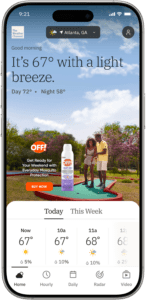
OFF! Integrated Marquee ad on The Weather Channel app
The creative engine behind contextual connection
Consumers remember how ads connect and make them feel. Integrated Marquee campaigns on The Weather Channel digital properties are designed to engage emotionally with a suite of perfectly timed, versioned creative on the home screen. Weather Targeting will serve your message at the right weather moment, but it’s the creative execution that sparks the emotional connection.
Each creative variation is thoughtfully designed to dynamically match the user’s current context – whether it’s a product bathed in sunlight during a summer sunrise or set against a moonlit snowfall on a wintry night. Powered by AI-driven personalization, high-impact creative aligns to the forecast, time of day, and location to deliver brand storytelling that feels intentional.
Campaigns include up to eight creative variations, enabling brands to dynamically customize emotionally aware imagery and copy that align with the viewer’s environment:
- Sunny day and clear night
- Rainy day and night
- Cloudy day and night
- Wintry day and night
The version that fits the time of day and weather conditions will be displayed on the home screen to complement the forecast. It’s like having a personal sales rep who knows exactly what your customer is experiencing and delivers the most relevant message possible in that moment. This approach turns passive impressions into active engagement through weather-based storytelling designed for relevance, scale, and stronger emotional connection.
Jeep® harnesses weather to fuel leads and brand lift
Jeep captured outdoor enthusiasts’ attention during their adventure planning routine by aligning messaging with real-time weather conditions.
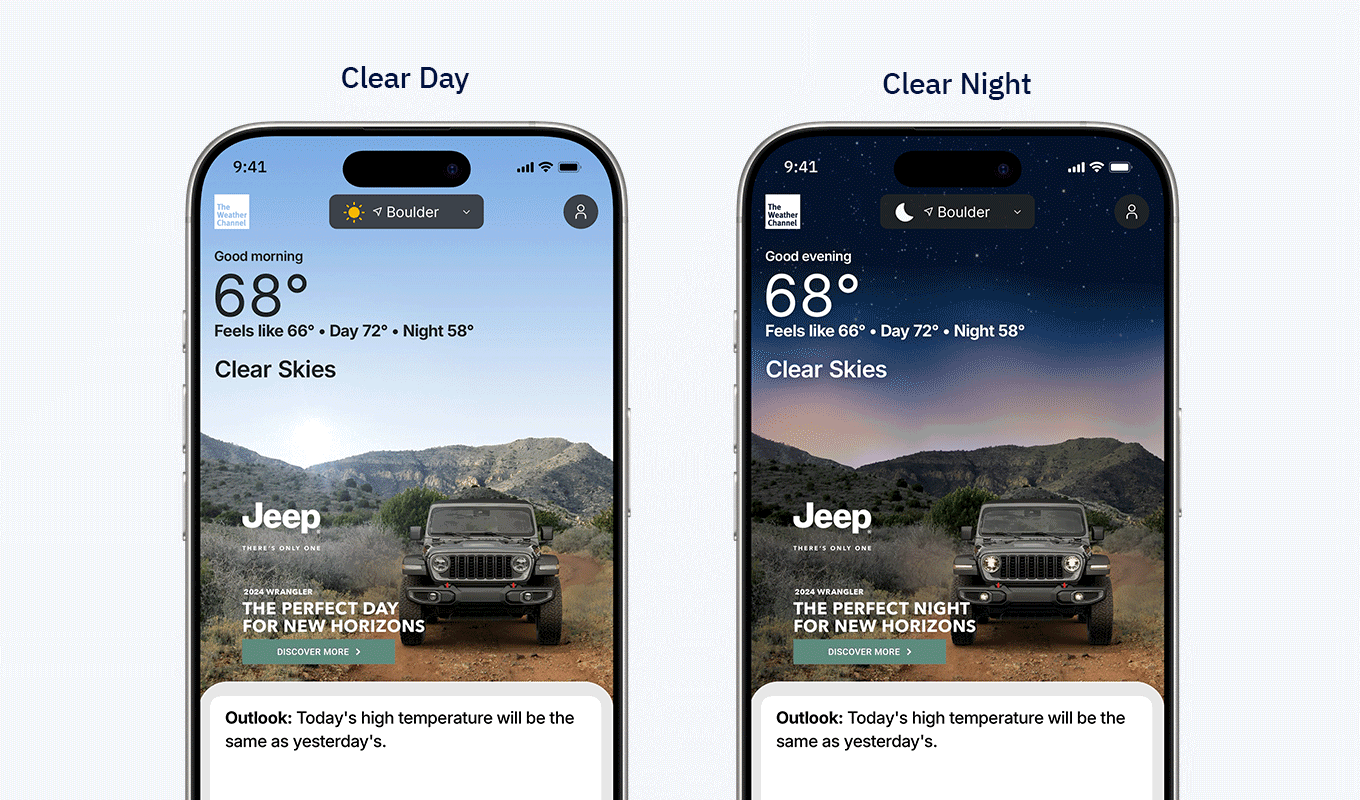
Core features that drive results
From context-aware creative to seamless e-commerce integration, these capabilities work together to deliver more relevant, more effective brand storytelling. Here’s how the Integrated Marquee helps marketers turn everyday conditions into powerful engagement opportunities:
- Weather intelligence: Dynamically adapts the creative based on location, accurate weather conditions, and time of day.
- E-commerce technology: Streamlines path to purchase by placing products directly into retailer’s shopping carts with a single click.
- Engaging creative formats: Custom-designed by our award-winning Creative Lab, formats include animated visuals, carousels, seamless auto-play video, and interactive conversations that launch into a branded chatbot experience.
The impact is clear. These ads deliver performance that traditional formats can’t touch:
higher attention rates8
higher click-through rates than standard ad formats9
The foundation of consumer trust: Industry-leading forecast accuracy
When it comes to weather-driven marketing, accuracy isn’t just a metric – it’s everything. The Weather Company is the most accurate forecaster globally, providing the reliable foundation that has made us one of America’s most trusted brands.10
What does this mean for advertisers?
- More contextually accurate weather-powered campaigns
- Better timing for seasonal promotions
- Improved efficiency through weather-based marketing decisions
- Stronger ROI on weather-influenced advertising spend
- A trusted, brand-safe environment to display your message
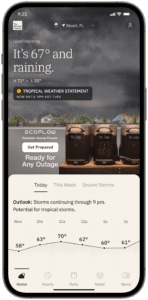
EcoFlow Integrated Marquee ad on The Weather Channel app
Industry-specific applications: Unleashing the power of weather-driven marketing
Brands have the freedom to choose a product from their portfolio that best matches the moment. Let’s explore how different categories can use Integrated Marquee ads to turn weather-powered creative into revenue:
Retail & e-commerce | Drive product demand year-round, from lawn mowers to snow blowers. Align products with seasonal needs and holidays.
Travel & hospitality | Convert weather checks into check-ins. Respond to real-time conditions with inspiration for rainy-day escapes or sunny imagery to inspire spring break travel during late winter doldrums.
Consumer packaged goods (CPG) | Supply weather demand. Highlight grilled hot dogs on sunny days or oven-ready entrees on rainy ones. Think sunscreen for your sunny day ad, replaced by a moisturizer ad when it’s wintry.
Entertainment & media | Set the perfect scene for movie and TV marketing. Reflect the forecast with comfy indoor visuals for streaming during rainy weather or sun-filled event imagery for outdoor venues on clear days.
Health & wellness | Remedy real-time needs. Feature current health conditions by featuring pollen indexes and allergy risk levels alongside relief products, or spotlighting cold and flu remedies like sore throat treatments in wintry visuals.
Sports & recreation | Get in the game at the perfect moment. Adapt creative imagery and messaging in real time – such as promoting tee times with sun-soaked visuals during ideal golf conditions or featuring fall football gear as temperatures drop.
Automotive | Fuel interest when it matters most. Serve up a snowy backdrop for all-wheel drive or a sun-drenched convertible to match what drivers are experiencing.
Restaurants | Feed demand based on weather conditions. Swap in patio-ready visuals during sunny weather or delivery messaging during rain or snow.
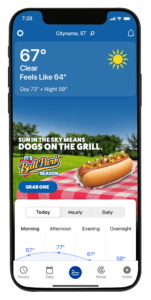
Tyson Foods Ball Park® Integrated Marquee on The Weather Channel app
Your next campaign starts here
Weather is personal. It shapes how we feel, what we do, and what we need, making it a powerful canvas for emotional marketing. Integrated Marquee ads help brands translate that moment-by-moment reality into authentic advertising that connects.
This is more than a media buy. It’s a scalable solution for brand storytelling – where data and design come together to reflect the mood, moment, and mindset of your audience.
Let’s bring your next story to life, one forecast at a time.
Let's talk
What’s your weather strategy? To learn more about harnessing the power of weather to increase engagement and drive growth, contact our advertising experts today.
Contact us1 9 GAM, 2024
2 8 Adelaide, 2023
3 The Weather Company Consumer Behavior Survey, Nov 2023
4 BusinessThink, UNSW, “For him it rains, for her it pours: how weather and gender impact consumption,” 2024
5 Based on the average of the total monthly (non-unique) users for Jan – Dec ’24 across The Weather Company digital properties and consumer products, according to internal, global data.
6 Amplitude, Adobe, 2024
7 Based on the average of the total monthly (non-unique) users for Jan – Dec ’24 across The Weather Company digital properties and consumer products, according to internal, global data.
10 According to a Morning Consult “Most Trusted Brands” survey for 2025
Editor’s note: This article originally published in Flight Global (June 17, 2025)
- Airlines face seasonal weather risks that can disrupt flight schedules and increase costs. Accurate forecasting helps reduce delays and improve planning.
- The Weather Company’s technology gives airlines early insights into threats like tropical cyclones, winter storms, and turbulence.
- Advanced forecasting tools like GRAF and TrACR offer specific guidance for flight paths and airport operations.
- Weather intelligence improves seasonal planning, safety, fuel efficiency, and on-time arrivals, even in challenging aviation weather conditions.
Airlines face a range of seasonal weather challenges – from summer turbulence to winter storms. These conditions can delay flights, raise costs, and put passengers at risk. Managing disruptions takes more than reacting in real time. It requires forward-looking, accurate weather intelligence that supports better decisions. By combining long-range forecasts with mid-term risk outlooks – such as 3-, 5-, and 7-day storm forecasts – airlines can adjust routes and reduce delays before severe weather hits.
To address these critical forecasting needs, The Weather Company delivers the world’s most accurate forecasts,1 and advanced meteorological intelligence that powers aviation decision making. Our Weather Mix (WxMix) system delivers mid-term aircraft weather forecasts using nearly 100 global models. It also includes The Weather Company’s proprietary Global High-Resolution Atmospheric Forecasting System (GRAF) for high-resolution updates. WxMix provides decision points up to 10 days in advance to help aviation leaders stay ahead of developing weather. These tools give airlines the confidence to adjust routes, allocate resources, and keep operations running smoothly even when the forecast turns volatile.
How seasonal weather disrupts airline operations
Seasonal weather puts constant pressure on airline performance. Each season brings its own set of risks. Winter storms can shut down airports with snow, ice, and low visibility. Tropical systems like hurricanes can force reroutes and cancellations across entire regions. In summer, turbulence from jet streams and storms causes mid-air instability, extra fuel use, and injuries.
Turbulence is a growing concern in aviation worldwide, and the changing climate is making it worse. A 2023 study from the University of Reading found skies are now 55% bumpier than 40 years ago.2 This finding demonstrates why airlines need accurate, near-term weather forecasts to help reduce risks and keep flights safe.
With these challenges in mind, airlines need more than daily weather updates. They require weather forecasts with a clear risk outlook for better contingency planning and resource allocation.
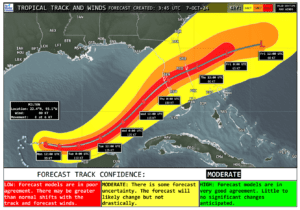
A clear and concise visualization of the storm’s anticipated impact
The power of mid-term forecasting for operational readiness
Advanced forecasting helps airlines get ahead of seasonal disruptions. The WxMix system delivers insightful and actionable mid-term outlooks, including 3-day tropical forecasts and 7-day winter storm projections. These insights let airlines adjust routes, move crews and aircraft, and prepare before severe weather arrives.
When airlines use these forecasts in aviation planning, they can make smarter choices about schedules, fuel use, and aircraft placement. For example, suppose a winter storm is expected at a key hub. In that case, they can move planes, reassign crews, and alert passengers in advance. If mid-term outlooks show an active hurricane season, airlines can update contingency plans early for the regions most at risk.
Real-time and near-term tools like GRAF and terminal airspace convective risk (TrACR) work alongside mid-term forecasts. They provide hyper-local, short-range updates to support last-minute decisions on flight paths, airport operations, and crew planning. With high-resolution weather intelligence, flight planners can make quick adjustments that keep flights on time and avoid disruptions.
Enhancing flight schedules and airport operations
Weather delays and cancellations cost airlines millions each year.3 That’s why operational efficiency is so important. The Weather Company offers real-time and near-term tools like Maverick™ Dispatch, Pilotbrief®, and Weather Data APIs. These help airlines manage flight schedules and keep airport operations running smoothly. The tools provide live updates on turbulence, storms, and other weather risks, giving dispatchers and pilots the data they need to act fast.
Maverick Dispatch is a flight-tracking tool that gives airlines a clear view of short-term weather risks. It combines real-time meteorological data with flight operations to help dispatchers reroute flights, choose alternate airports, and avoid delays before they grow. The TrACR feature adds hyper-local convective weather forecasts to show what to expect along arrival and departure routes.
It also includes Global Surface Movement (GSM) – a form of advanced airport operations technology – that gives near-real-time visibility into airport surfaces. It tracks aircraft positions, taxiway conditions, and gate availability. By showing where slowdowns might happen, GSM helps airlines cut tarmac congestion, save fuel, and improve turnaround times.

GSM quickly visualizes ramp, taxiway, and runway conditions
Real-world application: How Breeze Airways navigated hurricane disruptions
During the 2024 hurricane season, Breeze Airways used The Weather Company’s aviation tools to manage two major storms that hit Florida. While many airlines faced extended delays, Breeze kept operations intact and returned to service faster.
Using real-time flight tracking and live weather data, the dispatch team monitored aircraft and made quick decisions. They rerouted flights, adjusted schedules, and kept crews and passengers safe. As soon as Tampa and Fort Myers airports reopened, Breeze resumed service and avoided the long delays other carriers faced.
The Breeze case study shows how advanced forecasting helps airlines manage seasonal weather changes. With mid-term outlooks and real-time tools, airlines can make faster decisions, protect passengers, and stay on schedule even during major storms.
Improving passenger safety and comfort
Beyond operational efficiency, weather intelligence is vital for passenger and crew safety. The Weather Company’s Total Turbulence Alerting system gives pilots live updates to adjust altitude and reduce in-flight instability. Tools like Maverick Dispatch and Pilotbrief provide real-time data, which helps dispatchers reroute flights to avoid bad weather.
Turbulence is a growing issue, made worse by a changing climate. With near-term forecasts from GRAF, airlines can reduce in-flight instability and keep passengers more comfortable.
The Weather Company also provides METARs and TAFs – short-range forecasts that give dispatchers the most up-to-date weather before departure. These tools allow dispatchers to monitor developing aviation weather conditions, which helps avoid last-minute delays and cancellations.
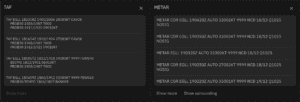
Access forecast conditions and see how the forecast has been changing over time
A smarter approach to seasonal travel
Seasonal travel brings a range of weather risks year round. Airlines that use a layered weather strategy – built on mid-term forecasts and powered by near-term and real-time tools – can increase resilience and reliability.
The Weather Company offers solutions with industry-leading accuracy that include 3- to 7-day outlooks, storm tables, and live systems like Maverick Dispatch. With detailed models and both near-term and real-time data, airlines can plan smarter, react faster, and keep operations running through all kinds of weather.
Let's talk
To learn more about our advanced aviation weather solutions, contact our aviation experts today.
Contact us1 ForecastWatch, Global and Regional Weather Forecast Accuracy Overview, 2021-2024, commissioned by The Weather Company
2 University of Reading, Evidence for Large Increases in Clear-Air Turbulence Over the Past Four Decades, 2023, based on research published in Geophysical Research Letters by Prosser et al.
3 The Weather Company, The impact of weather on international aviation, 2025
Weather forecasts shape critical decisions daily. From planning your morning commute to optimizing global supply chains — forecast accuracy isn’t just preferred, it’s essential.
But what does better accuracy actually mean for those who depend on it? Let’s look at the real-world impact in businesses across industries and why they place their trust in The Weather Company – the world’s most accurate forecaster.1
Advertising: Turning weather science into marketing ROI
 Consciously or subconsciously, weather influences every aspect and decision of people’s lives – how we feel, what we try, and what we buy. Even a one degree Celsius increase in temperature can lead to a 1.2% boost in consumer spending.2
Consciously or subconsciously, weather influences every aspect and decision of people’s lives – how we feel, what we try, and what we buy. Even a one degree Celsius increase in temperature can lead to a 1.2% boost in consumer spending.2
And it adds up: The National Retail Federation estimates that weather affects about $1 trillion in global sales annually.3 When it comes to delivering a brand message in the right moment, to the right people, the precision and accuracy of weather-targeted advertising isn’t just a nice-to-have, it’s a must have.
In today’s cluttered ad environment where every touchpoint counts, marketers can’t afford to waste budget or an opportunity to drive an action. Take it from Ryan Oliver, Head of Communications at EcoFlow — an emerging leader in portable power solutions: “The Weather Company’s credibility and accuracy helped us reach a highly engaged audience actively seeking solutions for weather-related outages, boosting awareness and interest in EcoFlow’s backup power solutions.”
Aviation: Better forecasts, safer flights
 In aviation, forecast accuracy directly impacts both safety, customer satisfaction, and profitability. Weather causes approximately 75% of all flight delays4 costing an airline an estimated around $60 billion annually.5 Further, weather conditions are the source of more than 65% of injuries to passengers and crew due to turbulence.
In aviation, forecast accuracy directly impacts both safety, customer satisfaction, and profitability. Weather causes approximately 75% of all flight delays4 costing an airline an estimated around $60 billion annually.5 Further, weather conditions are the source of more than 65% of injuries to passengers and crew due to turbulence.
With accurate, probabilistic forecasts, airlines can better anticipate disruptions before they happen — not just react to them. This leads to better, more efficient route planning, reduced fuel consumption, and happier passengers flying smoother skies. Take it firsthand from Nathan Polderman, Sr. Manager of Meteorology, United Airlines: “United Airlines’ operations are greatly enhanced from the accuracy of The Weather Company forecast data and the ability for their meteorologists — embedded in the United Network Operations Center — to quickly adjust and communicate nuances and uncertainties in the forecast. Precise and accurate weather forecasts are critical to United’s efforts to maintain safe and efficient operations and keep customers satisfied.”
Media: Building viewer trust
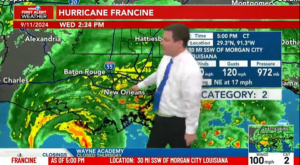 For broadcasters, forecast accuracy isn’t just about ratings — it’s the trust currency that makes viewers reach for their channel first. And in the highly competitive media landscape, trusted weather forecasts directly impact station credibility.
For broadcasters, forecast accuracy isn’t just about ratings — it’s the trust currency that makes viewers reach for their channel first. And in the highly competitive media landscape, trusted weather forecasts directly impact station credibility.
Consistent, accurate forecasts strengthen viewer loyalty and position the broadcast team as the authoritative weather source — either nationally or locally. As Patrick Bigbie, Chief Meteorologist, WDAM-TV, puts it: “The Weather Company’s GRAF model is the first one I check each day when building my forecasts and presentations. I find it very reliable and trustworthy enough to share with my viewers.” Mark Nelsen, Chief Meteorologist at KPTV & KPDX Television, adds: “We’ve been using The Weather Company’s GRAF model for over five years now. Its accuracy is remarkable and I’ve learned not to second guess it since it usually proves me wrong.” GRAF, a proprietary global weather modeling system, is just one of the many forecasting technologies built and used at The Weather Company to drive the accuracy of our weather forecast portfolio.
Government & defense: When missions and lives are at stake
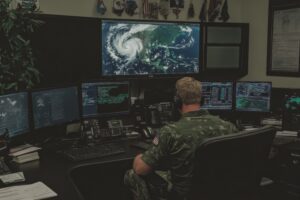 In defense operations, even minor weather forecast deviations can compromise asset deployment, technological capabilities, and personnel safety.
In defense operations, even minor weather forecast deviations can compromise asset deployment, technological capabilities, and personnel safety.
With weather intelligence that accurately predicts weather conditions on the ground and in the air, military personnel teams can better prepare for the operating conditions they’ll face in the field. This preparation allows for tactical adjustments that create strategic advantage. When adversaries rely on less accurate or incomplete information, your enhanced weather awareness becomes a decisive operational edge.
This tactical advantage becomes increasingly valuable in today’s more volatile operational environments. Gareth Collier, former Special Forces Officer, drives home the importance: “For military capability and personnel safety, forecast accuracy isn’t just a matter of convenience — it’s critical to both mission success and saving lives. Weather conditions affect everything across soldier welfare, platform preservation, and tactical advantage. Precise meteorological information is a force multiplier that enables optimal military strategy and operational planning.”
Not all forecasts are created equal
Many claim it, but only one forecaster can prove it: The Weather Company is the world’s most accurate forecaster.6 Delivering this level of accuracy doesn’t happen by chance. It requires a unique approach to weather forecasting that only The Weather Company has pioneered and continues to perfect.
Since our inception nearly five decades ago, we’ve combined human, meteorological expertise with proprietary, state-of-the-science technologies and AI to provide accurate forecasts and scalable solutions for people and businesses alike. And with that accuracy comes trust – trust that has earned us the distinction of being the most trusted weather provider and one of the top 15 most trusted brands among all adults in 2025.7
Solutions to thrive in the face of impactful weather
Accurate weather data helps instill confidence, drive decisions, and propel the world. That’s why we’re committed to continuous innovation of current and future solutions, including:
- Weather Data APIs: We deliver real-time and historical weather data that provides high-resolution, continuously-updated, and hyper-local intelligence.
- Consumer experiences: We’re trusted by more than 330 million monthly people each month across all digital properties including weather.com and The Weather Channel app.8 The Weather Channel app stands as the #1 most downloaded weather app in the U.S, a daily habit for over 50 million people.9
- Enterprise solutions: Our solutions power decisions for 2,000+ enterprise customers across media (600+ broadcast stations), aviation (25,000+ flights per day), government, defense, agriculture, insurance, automotive, retail, CPG, pharma, energy, and beyond.
The best of both worlds: Human expertise + AI precision
We combine human meteorological expertise with advanced AI to create forecasting capabilities that neither could achieve alone:
- Human guided, AI-powered approach: 100+ meteorologists collaborate with our AI systems through a “human over the loop” model, combining decades of expertise with cutting-edge technology to deliver fresh, precise, more accurate, and actionable forecasts.
- Scientific collaboration: Our ongoing work and dialog with the broader scientific community includes NCAR, UCAR, and NOAA, accelerating our innovation while advancing capabilities for everyone.
- Technological rigor: We process 75+ billion terabytes of data daily across 100+ forecast models to create 25+ billion personalized, on-demand forecasts for 2.2 billion global locations. As a component of that technology stack, our proprietary, high precision weather modeling system, GRAF, provides hourly updates that can predict something as small as a thunderstorm, virtually anywhere on the planet.
When weather shapes decisions, accuracy is the only option
For decisions that affect people and businesses everywhere, you need forecasts you can count on every time.
The question isn’t whether you can afford accurate weather intelligence, but whether you can afford to be without it. It’s your turn: Discover how our unmatched forecast accuracy can transform your business outcomes.
Let's talk
To learn more about harnessing the power of weather to make better, more informed decisions across industries, contact our experts today.
Contact us1 6 ForecastWatch, Global and Regional Weather Forecast Accuracy Overview, 2021-2024, commissioned by The Weather Company
2 3 LinkedIn: Raja Rajamannar, Weather Wizards: How Marketers Can Harness the Elements for Unprecedented Success, September, 17, 2024
4 FAA: FAQ Weather Delay
5 Cosmos, The Cost of Delays, Feb. 2025
7 According to a 2025 Morning Consult “Most Trusted Brands” survey
8 Based on the average of the total monthly (non-unique) users for Jan. – Dec. 2024 across The Weather Company digital properties and consumer products, according to internal, global data
9 According to Top Downloadable Weather Apps in 2024 in the US (by Downloads), from Sensor Tower (Jan. 1 – Dec. 31, 2024)
At this year’s Cannes Lions, the weather wasn’t just a backdrop — it was the story.
From sun-scorched yachts to rooftop panels that felt more like saunas, heat stole the spotlight right alongside AI. Fans became fashion statements. Shade was VIP real estate. And while creative ideas were buzzing, so were the forecasts — including ours, which accurately predicted the scorcher ahead of the Festival.
But here’s the thing: You didn’t have to be sweating along the Croisette to feel the heat.
Because as of last Friday, summer is officially here — and it’s coming in hot. Literally.
This week, more than 150 million Americans are under extreme heat alerts as a massive heat dome settles over the Midwest and Northeast. Records are being shattered. Power grids are strained. And cities from Chicago to New York are facing triple-digit temperatures.
The heat is on — for everyone
This heat wave is more than a passing discomfort — it’s a strategic inflection point. One that reinforces the same takeaway we saw in Cannes: You can’t control Mother Nature — but you can absolutely control how ready you are for her.
What the forecast tells us
- A massive heat dome has parked itself over the Midwest and Northeast, creating several days of scorching heat — not just triple-digit “feels-like” temps, but actual air temps topping 100°F in multiple cities.
- Even major urban centers are breaking old records: Boston already hit 102°F, mirroring Phoenix; New York’s Central Park is flirting with 100°F — the first June 100-degree day since 1966.
- Nighttime offers zero relief. Overnight lows stuck in the 70s or higher mean no cooldown — just baked-in fatigue.
- Dangerous humidity compounds the issue: dew points in the 70s are amplifying the heat index — turning 100°F days into 110°F+ feels-like situations.
- Millions face health risks and disruption: travel delays, train slowdowns, stressed power grids, and canceled events are all rolling out in real time.
For the most up-to-date forecasts and alerts, head to weather.com or check The Weather Channel app.
This isn’t a brief summer flare-up – it’s a multi-day, city-wide test of resiliency. And as Cannes taught us, the brands that see the heat coming are the ones best equipped to lead through it.
Lessons for brands: Don’t just react. Forecast. Adapt. Lead.
-
The forecast is a strategic tool
Just like our Cannescast let attendees plan ahead for the heat, brands need environmental intelligence to anticipate how conditions will impact everything from supply chain to customer mindset.
-
Adaptability isn’t a luxury — it’s growth fuel
At Cannes, some brands scrambled with last-minute giveaways. Others used AI and data to shift campaigns, activations, even locations – on the fly. Those are the brands that won the moment and the message.
One standout? FCB and Hyundai Motor won two Gold Lions and one Silver Lion in the Digital Craft category for its ‘Tree Correspondents’, the company’s first brand campaign on the ‘IONIQ Forest.”
The campaign uses data from The Weather Company and AI to analyze ecological data from global IONIQ Forests, providing insights into forest health and biodiversity through innovative storytelling. That’s not just award-worthy creativity — it’s future-proof thinking.
-
Your customers are hot, too — help them
Whether it’s sun-safe products, hydration-ready bundles, or location-aware messaging, the brands that offer relief are the ones that earn relevance. Consumers remember who showed up with empathy and action.

Each year, we honor select Rainmaker brands and agencies innovating with weather in groundbreaking ways.
From climate to commerce: Why AI is the great equalizer
In an unpredictable world, AI turns chaos into clarity. It allows marketers to model scenarios, tailor messaging to hyperlocal conditions, and pivot in real time. Not just to survive the heat — but to build resilience, drive growth, and actually thrive in it.
The takeaway? Don’t get caught fanning yourself in the heat. Be the one handing out the shade — with strategy.
Summer’s here. The heat is real.
Is your brand ready to handle it — or harness it?
Let’s make this season a case study in how foresight fuels resilience.
Want to stay ahead of the heat — and your competition? Reach out to The Weather Company team to explore how we can help you turn environmental intelligence into strategic advantage. From AI-driven insights to climate-informed campaigns, we’re ready to partner with brands that want to lead, not just react.
And if you missed us in Cannes (or just want to relive it), check out our sizzle reel — yes, it’s hot in more ways than one.
Cannes Lions Festival of Creativity 2025
From blazing temperatures to bold ideas, Cannes Lions 2025 delivered heat in every sense. Relive how The Weather Company and our incredible partners stood out — with powerful insights, purposeful creativity, and a forecast-first mindset that turned climate and data into opportunity.
Let's talk
What’s your weather strategy? To learn more about harnessing the power of weather to increase engagement and drive growth, contact our advertising experts today.
Contact usEvery June, the global creative community descends on the sun-drenched shores of the French Riviera for the Cannes Lions International Festival of Creativity. What began as a celebration of the world’s best advertising has evolved into a sprawling summit of ideas, innovation, and influence, spanning brand storytelling, cutting-edge technology, consumer insight, and cultural trends.
In 2025, this convergence of creative forces occurs amid a complex and rapidly shifting backdrop.
Climate volatility is no longer a future risk – it’s a present reality, affecting everything from travel logistics to campaign planning. Artificial Intelligence, once a curiosity, has become a cornerstone of marketing operations, prompting urgent questions about ethics, integration, and impact.
Meanwhile, consumers are more connected, discerning, and demanding than ever before. They expect personalization, authenticity, and purpose – not someday, but now.
Amid all this change, one truth remains: those who adapt to the moment will influence what comes next. That’s where The Weather Company steps in.
At The Weather Company, we know weather is more than a forecast; it’s a behavioral, emotional, and economic force. From influencing what consumers buy to when and how they travel, shop, and engage, the weather shapes decisions at scale. And with the right intelligence, it becomes a powerful creative asset.
The Cannescast is your guide to Cannes Lions 2025 – what’s ahead, what’s heating up, and how brands can turn uncertainty into opportunity. From weather trends to tech talk, creator power to AI progress, we’ll explore the themes that will define this year’s festival and beyond.
Mother Nature: the main event
Let’s start with the skies above.
While Cannes is known for its balmy Mediterranean climate, the weather has a way of influencing the mood, movement, and marketing magic of the festival.
 A sudden downpour can scatter beach activations and push networking inside; an unexpected heatwave can drive attendees for some shade rather than sit through sessions. And a cool, breezy evening can transform a casual happy hour into a brand’s most memorable oceanside engagement.
A sudden downpour can scatter beach activations and push networking inside; an unexpected heatwave can drive attendees for some shade rather than sit through sessions. And a cool, breezy evening can transform a casual happy hour into a brand’s most memorable oceanside engagement.
After a few years of mood swings – 2022’s rain and heat, 2023’s wind-whipped chaos, and 2024’s cool-down throwback to 2014 – Cannes 2025 is bringing the heat. Literally.
This year’s festival is shaping up to be a sun-soaked scorcher. Forecasts call for warm, dry conditions with highs well above average. This will most likely mean low 80s°F/high 20s°C, with a real possibility of hitting 86°F/30°C. Thunderstorms aren’t likely, but never say never. While we see the highest chance of dry weather, it may not stay that way, with risks of isolated showers and thunderstorms on Monday, June 16 and Thursday, June 19.
The Mediterranean is running hot too, with sea surface temps into the low 70s°F/low 20s°C. That’s a potentially positive signal for sustained summer vibes across the region. Weather models point to a dry lead-up this week with temps steadily rising to the 82-86°F/28-30°C range. The main wildcard will be gradual heat buildup, with the hottest temperatures expected in the days immediately ahead of the festival. There’s growing potential for a spike into the upper 80s°F/low 30s°C, especially across southern France – make sure to break out the SPF if you’re arriving early.
In other words, prepare for a festival that’s creatively and meteorologically hot. Of course, Mother Nature can be fickle, so the best way to stay in the know and ahead of any proverbial storm is to frequently check The Weather Channel app or weather.com.
Hot topics: what’s on our radar
Each year, Cannes serves as a cultural barometer for the marketing world. The ideas that spark conversation here often ripple outward, shaping strategy and budgets across the globe. Here’s what we predict will define the discourse in 2025:
Creators take center stage
The creator economy is no longer a side hustle; it’s a core brand strategy. In 2025, the focus is shifting: it’s not just about reach or viral trends. Creators are becoming true co-authors of brand narratives.
 This year brings deeper conversations around creator equity, ownership, and voice. Influencers want creative control, and brands are moving toward long-term, purpose-driven partnerships.
This year brings deeper conversations around creator equity, ownership, and voice. Influencers want creative control, and brands are moving toward long-term, purpose-driven partnerships.
Audiences are savvier than ever. They can spot forced content instantly, and when it feels fake, engagement drops. In 2025, authenticity is no longer optional.
The most effective brand stories will be co-created with creators who offer not just reach, but real resonance. These are voices with credibility, lived experience, and a deep connection to their audiences.
But collaboration alone isn’t enough. Smart brands will also prioritize context, delivering content that’s not only well-made but perfectly timed, placed, and attuned to the moment. The result will be content that not only reaches people but also moves them.
AI: from “wow” to “how”
Dare we say… the only thing people may be talking about more than weather is AI. We’re right there, too. AI has long played an important role in how we’ve consistently been recognized as the world’s most accurate forecaster.1
Expect forward-thinking conversations about how AI can solve real problems, with an eye on ethics, authenticity, and impact.
- Beyond the hype: From tool to teammate | AI won’t just be discussed as a creative shortcut – it’ll be positioned as a true collaborator. Expect panels and brand activations to explore how AI augments human creativity, not replaces it.
- Authenticity + intelligence | There’s growing tension between AI-generated content and the human need for authenticity. Expect conversations around how brands can strike that balance – especially in campaigns that rely on emotion or identity.
- Measurement, ROI, and creative impact | This year’s big question: “Does AI-driven creative actually perform better?” You’ll hear more about how AI is being used to optimize campaigns and drive measurable outcomes, especially as marketing budgets tighten.
- Ethics, ownership, and creative credit | The conversation around AI’s legal, ethical, and cultural implications is heating up. Cannes panels will likely tackle questions like: Who owns AI-generated work? How do we ensure DEI in data-driven creativity? Can brands build trust while using AI?
- AI for good | Some of the more forward-looking brands will focus on AI’s potential to address changing climate, crisis response, and social impact – aligning with Cannes’ increasing focus on purpose-driven work.
Storming the scene: must-attend sessions
We’re sprinkling our insights throughout the festival this year and welcome you to join the conversation.
Monday, June 16 | 10:30 am
Power Panel: Navigating the Future of Modern Marketing
T-Mobile Cabana
Monday, June 16 | 1:00 pm
Meet the Rainmakers: Leading Brands Revolutionizing Consumer Connection
Brand Innovators Beach, Rado Plage
Monday, June 16 | 1:30 pm
The Future of Audio in an AI-Driven Creative Landscape
LBB & Friends Beach, 65 Bd de la Croisette
Wednesday, June 18 | 1:30 pm
Agency, Opportunity and Hope, An Optimist’s View of the Climate
LBB & Friends Beach, 65 Bd de la Croisette
Can’t make our sessions? You can still get inspired. At The Weather Company, we partner with forward-thinking brands that use data and context to fuel creativity and impact. We call them Rainmakers — marketers who know that smart strategy is the real superpower behind standout work. These campaigns show the power of contextual creativity. From shifts in the sky to shifts in behavior, the best marketing is rooted in the moment and executed with precision.
Meet the 2025 Rainmakers turning insight into influence

Why: Drive consideration for the all-electric Wagoneer S-EV among adventure-minded consumers.
How: Jeep tapped into the natural synergy between weather, wanderlust, and the open road. By aligning creative with peak outdoor travel moments (long weekends, hiking season, warm-weather getaways), the brand reached audiences in a planning mindset. Using weather-driven insights, Jeep delivered immersive takeovers across high-impact channels, showcasing the Wagoneer S-EV’s power and performance when adventure was quite literally in the air.
By meeting consumers when they were dreaming, booking, and packing, Jeep made the Wagoneer S-EV feel less like a concept and more like their next great escape.
Why: Boost sales of weather-sensitive auto care products like Armor All® and A/C Pro®.
How: Energizer leaned into seasonality and precision, targeting key markets when conditions were ideal for car care (think: sunny weekends, rising temperatures, and road trip season). Using localized weather triggers, the brand activated timely campaigns with custom creative that spoke directly to consumers’ needs in the moment. Placements spanned native video, home screen takeovers, and programmatic buys via The Trade Desk and Meta to maximize reach and relevance.
By syncing messaging with real-world conditions, Energizer transformed routine maintenance into a real-time decision, enhancing both visibility and conversion when intent was naturally high.
Why: Educate families to help them anticipate mosquito activity and plan protection ahead of time.
How: SC Johnson’s OFF! turned seasonal annoyance into strategic foresight with OFF!Cast, a predictive mosquito activity index powered by proprietary and weather data. By forecasting where and when mosquito outbreaks were likely, the brand delivered hyper-targeted messaging across digital, social, DOOH, and even retail via Salesforce. The goal: align consumer demand with on-shelf inventory before the bites begin while increasing confidence in their ability to enjoy the great outdoors.
OFF! met families with helpful, proactive guidance by turning weather data into peace of mind and smarter purchase timing.
 Why: Make the global issue of deforestation feel human and immediate through emotionally resonant storytelling — advancing Hyundai’s sustainability mission by connecting audiences to the natural world in a more personal and powerful way.
Why: Make the global issue of deforestation feel human and immediate through emotionally resonant storytelling — advancing Hyundai’s sustainability mission by connecting audiences to the natural world in a more personal and powerful way.
How: Created by FCB New York, Tree Correspondents transformed weather data and real-time environmental data from Hyundai’s IONIQ Forest into compelling, emotionally resonant stories – giving trees a voice like never before. The campaign used a combination of AI, custom-built language models, and a network of sensors to capture hyperlocal tree data, including soil health, weather patterns, and environmental stress. These signals were then translated into first-person narratives from the perspectives of trees – giving newsrooms around the world a live journalistic tool to help elevate awareness of deforestation.
This memorable, mission-driven experience shifts the climate conversation from abstract statistics to immersive, first-person accounts of life in a changing forest – giving nature a role it never had before: that of the source.
![]()
Why: Build awareness for EcoFlow’s portable power stations during peak outage season, when reliability and self-sufficiency are top of mind for consumers.
How: EcoFlow tapped into a rising consumer need: staying powered and prepared in the face of increasingly erratic weather. By leveraging The Weather Company’s real-time forecasting, the brand delivered dynamic, hyper-relevant messaging before and after major weather events, positioning its products as timely, trusted solutions. Creative was synced with local forecasts and deployed across high-impact channels, including The Weather Channel app, The Trade Desk, and Meta, ensuring reach and resonance when audiences were most alert and action-ready.
It wasn’t just about promoting power — it was about empowering people to stay safe, connected, and in control when the grid couldn’t deliver.
Weather ready = travel steady
 Let’s not forget: before the panels, parties, and presentations come planes, trains, and packing. In 2025, travel is as up in the air, as ever. In fact, according to the FAA, 75% of air traffic delays are due to inclement weather.2 Which is why our work with airlines is so critical: 25K flights per day rely on The Weather Company for safe passage and minimal logistical bottlenecks.
Let’s not forget: before the panels, parties, and presentations come planes, trains, and packing. In 2025, travel is as up in the air, as ever. In fact, according to the FAA, 75% of air traffic delays are due to inclement weather.2 Which is why our work with airlines is so critical: 25K flights per day rely on The Weather Company for safe passage and minimal logistical bottlenecks.
Be sure to check out our newly launched in-app Air Travel feature that provides travelers with real-time, hyperlocal forecasts and insights into delays and cancellations for every leg of your journey, empowering them to make smarter decisions from takeoff to touchdown.
Otherwise, whether you’re jetting in from New York or hopping a train from Paris, here are a few quick tips to help ensure smooth skies:
Quick-hit travel tips
- Check your departure and arrival airports the night before — weather delays in one region often cause ripple effects across the entire air traffic network.
- Watch the weather at your layover — a sunny departure doesn’t guarantee a smooth connection, so keep tabs on every stop in your itinerary.
- Pack for the unknown — a light jacket, backup battery, and versatile shoes can save you when plans shift from panels to pop-ups.
- Hydrate early and often — between the Riviera sun and a completely booked agenda, it’s easy to overlook taking some sips of H2O until you’re running on fumes.
- Dress for humidity, not just heat — opt for light, breathable fabrics and a hat as part of your unofficial Cannes uniform.
- Respect the sun — use SPF 50+ or higher, reapply regularly, and don’t hesitate to seek some shade while networking between sessions.
- Keep a regular sleep schedule — a packable cooling pillow might be the unsung hero of your Cannes survival kit.
The Cannes Lions experience should start with excitement, not stress. With the right forecast, you travel smarter, arrive ready, and make every moment count.
Creativity in any climate
Cannes Lions 2025 is shaping up to be yet another memorable moment for the work on display, as well as for how we think about creativity, technology, and the role of real-time weather intelligence. From climate-aware storytelling to AI-powered activations, the future belongs to those who can read the moment and respond with relevance.
At The Weather Company, we’re here to help you (and companies across industries) make better, data-driven decisions. Whether you’re on the ground in Cannes or watching from around the globe, we invite you to stay curious, stay prepared, and stay tuned.
Skies may shift – but bold ideas always shine. See you on the Croisette.
Let's talk
What’s your weather strategy? To learn more about harnessing the power of weather to increase engagement and drive growth, contact our advertising experts today.
Contact us1 ForecastWatch, Global and Regional Weather Forecast Accuracy Overview, 2021-2024, commissioned by The Weather Company
2 Federal Aviation Administration FAQ
Key takeaways:
- Personalized video advertising using weather insights helps create more relevant viewer experiences.
- Weather data provides a privacy-compliant signal that enhances CTV targeting capabilities.
- Ad targeting based on weather allows for dynamic creative tailored to viewer mindsets.
- Brands can benefit from improved ROI by integrating real-time weather targeting into CTV strategies.
The growing connected TV (CTV) landscape holds incredible promise for the long-awaited full-funnel, data-rich marketing opportunity. It’s why digital video is expected to generate 60% of the total TV/video ad spend in 2025, double its share from just five years ago.1 Additionally, a report by the IAB shows 36% and 32% of U.S. advertisers plan to reallocate spend from social and search, respectively, into CTV this year.2
By revolutionizing the advertising market with new ad tiers and advanced targeting capabilities, CTV has captured the attention and dollars of brands around the world. But with the influx of spend comes increased competition for consumer attention. What’s the secret weapon that smart marketers are deploying to cut through the clutter? It’s not a new technology platform. It’s something far more fundamental and universally understood: the weather. Get ready to discover how this ubiquitous force is revolutionizing CTV advertising.
CTV continues to grow, but targeting gets tougher
CTV adoption has surged. More households are streaming than ever before, and ad spend is following close behind. In fact, U.S. CTV ad spend is expected to reach $33.35 billion in 2025, making up 9.6% of total digital ad spend.3
However, targeting those viewers effectively has become more complex. Privacy rules are tightening, and platforms are protecting user data. Traditional tools like behavioral targeting and device IDs no longer deliver the precision advertisers want. As competition grows, brands need to stand out without intruding.
Viewers now expect ads to feel helpful, not disruptive. They want content that fits the moment, especially when streaming their favorite shows. That’s where CTV targeting capabilities shine – when they connect context to content in ways that feel natural and timely.
Weather creates powerful, real-time relevance
In a cluttered media environment, brands compete for limited attention, forcing them to find smarter, more relevant ways to connect with audiences. Demographics can’t capture what a person is feeling in the moment. Weather can. It influences what people do, how they feel, and what they buy. A sunny afternoon might inspire a barbecue, while a cold snap could spark a soup craving or a new coat purchase.
Ad targeting based on weather offers a unique advantage: It respects privacy while still delivering relevance. Weather doesn’t rely on personal identifiers. It works for every ZIP Code, every product category, and every stage of the funnel.
Here’s why weather data is especially powerful for CTV viewer engagement campaigns:
- Dynamic and real-time: Adapts to shifting consumer behaviors and mindsets as conditions shift
- Privacy-compliant: Doesn’t rely on personal identifiers, aligning with evolving data regulations
- Universally applicable: Effective across product categories and geographies
- Predictive: Supports campaign planning based on forecasted weather trends
And with The Weather Company’s probabilistic forecasting accuracy, advertisers can plan campaigns around future conditions – not just react to past trends or behaviors.
How Weather Targeting integrates with CTV
Weather Targeting fits seamlessly into existing CTV ad tech. The Weather Company’s data connects with demand-side platforms (DSPs) and supply-side platforms (SSPs), making it easy to activate across major streaming environments. Campaigns can launch based on real-time, historical, or forecasted conditions. Ahead of snowfall, auto brands might emphasize winter-ready vehicle features, while travel brands promote sunny escapes to cold-weather audiences. Sportswear companies could spotlight gear for damp conditions, and retailers might pivot to home entertainment promotions during heatwaves.
Real-time weather data supports hyperlocal targeting and dynamic creative optimization. Marketers can tailor video assets to fit local conditions to make sure the message is always relevant to the consumer’s physical and emotional environment.
Industry examples show a strong impact
Across sectors, brands are seeing measurable results from weather-informed campaigns, with research showing that businesses leveraging weather intelligence can achieve revenue gains of 5-10% and reduce operating expenses significantly.4 By aligning ads with current or forecasted conditions, advertisers can deliver messages that feel timely and relevant – often before a consumer even begins searching.
Here’s how Weather Targeting is being applied across key industry verticals:
- Retail: Promotes seasonal merchandise when weather creates the optimal mindset to shop online, such as during dreary or humid conditions.
- QSR/Food & Beverage: Suggests weather-appropriate menu items, such as iced drinks during heatwaves or soup during rainy spells.
- Automotive: Highlights features like all-wheel drive or safety features when snow or icy conditions are forecasted.
- Entertainment/Travel: Capitalizes on indoor or outdoor activities, such as pushing movie streaming during storms or beach travel during sunny stretches.
- CPG/Pharma: Aligns with weather-driven health needs, including allergy medication during high pollen days or skin care during dry winter conditions.
Weather Targeting gives advertisers a strategic edge. It lets them speak to real needs, right when viewers are most receptive. That kind of timing boosts engagement and drives action.
Looking ahead: Even smarter weather data
Today’s forecasting tools deliver game-changing accuracy and hyperlocal precision, empowering marketers to plan with unwavering confidence. And the innovation doesn’t end there. As CTV integration breakthroughs emerge, the ability to directly link exposure to outcomes is becoming a reality. Prepare for weather data to become a cornerstone of your targeting strategy, offering access to predictive intelligence you’ve never had before, adding ease and flexibility to activation by being accessible through almost all DSPs. This isn’t just about knowing the forecast; it’s about predicting campaign success. The future of high-performing CTV campaigns demand a deep understanding of the dynamic relationship between weather, content, and commerce.
The Weather Company: Where unrivaled accuracy meets unmatched insight
As the world’s most accurate forecaster,5 we offer more than just weather data; we provide the key to unlocking unparalleled relevance in a cookieless landscape. By understanding the profound impact of weather on behavior, our targeting solutions equip brands with a distinct advantage in today’s crowded media ecosystem. Don’t just navigate the future of advertising; anticipate it, connect with it, and thrive within it – powered by the precision of The Weather Company.
Let's talk
What’s your weather strategy? To learn more about harnessing the power of weather to increase engagement and drive growth, contact our advertising experts today.
1 Interactive Advertising Bureau (IAB), Digital Video Is Set to Capture Nearly 60% of All TV/Video Ad Spend in 2025, CTV Rebounds to Double-Digit Growth in 2024, According to IAB, February 2024.
2 Interactive Advertising Bureau (IAB), 2025 Digital Video Ad Spend & Strategy Report: Part One, April 2025.
3 eMarketer, US Connected TV (CTV) Ad Spending Forecast, November 2024.
4 The Weather Company, Weather Means Business: The Role of Weather Intelligence to Drive Business Resilience, Growth, and a Competitive Advantage, 2024.
5 ForecastWatch, Global and Regional Weather Forecast Accuracy Overview, 2021-2024, commissioned by The Weather Company
- Weather intelligence can offer a strategic edge for QSRs facing rising tariffs and supply chain pressures.
- Weather data paired with sales and supply chain data can help identify seasonal consumer behavior shifts to better inform and guide menu planning.
- Targeted weather-based promotions can help drive efficient customer engagement during economically sensitive periods.
- The combination of weather and supply chain insights supports agility and operational efficiency in tariff-impacted markets.
The quick service restaurant (QSR) market operates in a pressure cooker, constantly balancing customer demand, operational efficiency, and fluctuating costs. Now, throw in the uncertain impact of tariffs, which can impact ingredient prices, supply chain stability, and even consumer spending habits. In this volatile environment, QSRs need every advantage they can get.
of US adults are likely to cut back on fast-food if tariffs lead to higher prices1
Think about the ripple effects of tariffs and food prices. Increased costs for imported ingredients might require menu adjustments or price increases. This, in turn, could influence customer choices. Simultaneously, weather continues its relentless cycle, impacting everything from foot traffic, to ingredient availability, to delivery demand. Smart QSR operators are realizing that understanding the interplay between these economic pressures and weather patterns is the key to staying ahead.
The strategic advantage: Weather intelligence in a tariff-sensitive market
While you can’t control global trade policies, you can control how you leverage data to navigate the resulting challenges. And one of the most powerful, often overlooked, data sources is weather intelligence. Imagine this: Tariffs drive up the price of a key ingredient for your popular summer menu item. You need to pivot. Weather intelligence can help provide crucial insights:
- Demand forecasting for alternatives: If the cost of imported beef for burgers increases, you might consider promoting chicken or vegetarian options. Weather patterns can help predict which of these alternatives will be most popular in different regions and at different times. For example, a heatwave might drive demand for lighter, non-beef options. In fact, 42% of people say they buy lighter and healthier foods when summer arrives.2
- Optimizing promotions: To offset potential price sensitivity due to tariffs, targeted weather promotions become even more critical. Weather-driven offers can drive traffic during specific times. A “rainy day comfort food” promotion might entice customers even if overall spending is tighter due to economic concerns. This is especially relevant considering that 61% of people choose more convenient food options, like delivery or quick meals, during hot or humid weather.3
 Supply chain agility: Weather and supply chain factors can exacerbate disruptions, especially for temperature-sensitive goods. Granular weather forecasts can help anticipate potential delays and inform inventory management, ensuring you have the necessary ingredients on hand without overstocking (especially important when ingredient costs are fluctuating due to tariffs). For instance, knowing a major storm is approaching a key distribution hub allows for proactive adjustments to delivery schedules.
Supply chain agility: Weather and supply chain factors can exacerbate disruptions, especially for temperature-sensitive goods. Granular weather forecasts can help anticipate potential delays and inform inventory management, ensuring you have the necessary ingredients on hand without overstocking (especially important when ingredient costs are fluctuating due to tariffs). For instance, knowing a major storm is approaching a key distribution hub allows for proactive adjustments to delivery schedules.
- Menu diversification based on local conditions: Tariff impacts might vary regionally. Weather intelligence can help identify regional preferences for different menu items. If a certain region is experiencing an unusually cold spring, promoting warmer, heartier options might be a smart strategy, regardless of broader economic trends. Remember, 33% of people say spring weather impacts when they order food for delivery.4
The Weather Company: Your navigator through economic and meteorological uncertainty
The Weather Company, the world’s most accurate forecaster5 provides QSRs with the sophisticated tools needed to not only understand weather’s impact but also to strategically respond to the challenges posed by a fluctuating economic landscape:
- Hyperlocal, predictive weather data: Get down-to-the-minute forecasts for each of your locations, enabling more informed adjustments to staffing and inventory in response to immediate weather conditions, which can amplify or dampen the effects of tariff-related price changes.
- Historical weather analytics paired with sales data: Analyze how past weather events and periods of economic change (like previous tariff implementations) impacted specific menu item sales. This dual-layered analysis provides deeper insights for future planning – perfect for streamlining QSR operations.
- Targeted marketing powered by weather: In a tariff-conscious market, highlighting value is key. Use weather conditions to promote family meal deals on stormy evenings or discounts on less expensive menu items during periods of economic uncertainty – boosting customer engagement in restaurants.
- Operational optimization for cost efficiency: Efficient delivery routes based on real-time weather can help save on fuel costs, a crucial factor when other operational expenses might be rising due to tariffs. Accurate staffing based on weather-driven demand prevents overspending on labor during slow periods.
of executives say weather has a moderate or high impact on their business6
Thriving in the face of change: QSR resilience powered by weather intelligence
The QSR industry has always been about adapting to customer needs and market conditions. In an era marked by both a changing climate and economic headwinds like tariffs, the ability to leverage data for informed decision-making is key. Weather intelligence from The Weather Company isn’t just about predicting rain; it’s about providing a strategic lens through which QSRs can better understand customer behavior, optimize operations, and ultimately, build resilience in the face of any challenge.
Ready to equip your QSR business with the intelligence to help navigate both meteorological and economic storms? Discover how The Weather Company can be your strategic advantage.
Let's talk
Contact our experts today to discover how weather data can empower your decision-making and strengthen your business resilience. Let us help you transform weather data into a strategic asset for your business.
Contact us1 CivicScience, February 2025
2 3 The Weather Company, Summer 2023 Behavior Survey, March 2023
4 The Weather Company, Spring 2022 Behavior Survey, December 2021
5 ForecastWatch, Global and Regional Weather Forecast Accuracy Overview, 2021-2024, commissioned by The Weather Company
6 The Weather Company (in collaboration with Magid), Weather Means Business Report, October 2024
- Predictive analytics help optimize airport operations, reducing delays and improving efficiency.
- Real-time weather monitoring enables faster responses to aviation weather conditions, enhancing safety.
- Airport operations technology minimizes taxi delays, fuel waste, and ground congestion.
- Accurate aircraft weather forecasts improve flight routing, turbulence avoidance, and passenger experience.
Weather is one of the most significant factors affecting airport efficiency, often leading to costly delays, flight cancellations, and logistical bottlenecks. While traditional forecasting methods provide a general outlook, they lack the precision needed for dynamic airport operations. Advanced weather intelligence from The Weather Company is changing that, offering predictive analytics, real-time monitoring, and data-driven decision-making tools that help aviation leaders minimize disruptions.
By integrating cutting-edge airport operations technology, airports can proactively respond to aviation weather conditions, to help improve everything from runway management to gate assignments. With more accurate forecasts, airlines and ground crews can better anticipate adverse weather and airports can function more smoothly, leading to better passenger experiences and operational savings.
The impact of weather on airport operations
Weather is responsible for a significant portion of air travel disruptions. According to industry data, 74% of flight delays exceeding 15 minutes can be directly attributed to weather-related issues.1 Snow, thunderstorms, turbulence, and low visibility can halt or slow down airport activity, creating a ripple effect that affects airlines, ground crews, and passengers.
The consequences of these disruptions are costly. In 2024, travelers lost more than 20 minutes to taxi-out times at some of the nation’s biggest airports, with LaGuardia topping the list at 23 minutes.2 These delays not only inconvenience passengers but also contribute to excessive fuel burn and increased emissions. Inefficient ground operations and flight delays can cost airlines millions annually, making airport operations optimization a key priority.
How predictive analytics optimizes airport efficiency
Our advanced airport operations technology leverages predictive analytics to help airports better prepare for and respond to aviation weather conditions. Unlike traditional weather monitoring systems, predictive analytics can provide highly detailed, location-specific insights that allow airports to make proactive operational decisions.
For example, predictive analytics can help optimize runway usage by forecasting when storms or snow will impact airport operations. Rather than reacting to adverse conditions as they occur, airports can deploy de-icing teams in advance, re-evaluate ATFM slots based on expected delays, and provide alternative landing paths to minimize holding patterns. These proactive measures significantly reduce disruptions, allowing flights to stay on schedule even in challenging weather conditions.
Industry research suggests that with more accurate and timely weather predictions, airports could prevent as many as two-thirds of weather-related delays and cancellations.3 By integrating predictive analytics into their decision-making processes, aviation leaders can transform weather from an operational obstacle into a manageable factor.
Real-time weather monitoring for smarter decision making
In addition to predictive analytics, real-time weather monitoring from The Weather Company plays a crucial role in airport operations efficiency. While long-term forecasts help with planning, live weather data is essential for managing day-to-day airport logistics.
Global Surface Movement within Maverick™ Dispatch provides this critical data. This critical feature provides continuous, high-resolution monitoring of runway conditions, arrival and departure trends, and taxiway congestion. With this data, dispatchers and pilots can better coordinate pushback and taxiing, reducing unnecessary delays and improving fuel efficiency.

GSM quickly visualizes ramp, taxiway, and runway conditions
For instance, by tracking real-time runway conditions, dispatchers can better determine whether an aircraft will soon be cleared for takeoff. This allows pilots to decide whether to taxi using only one engine, conserving fuel if a longer wait is expected. At high-traffic airports where taxi-out delays can exceed 30 minutes, such optimizations lead to significant cost savings and lower carbon emissions.
Real-time weather monitoring also enables airports to adjust operations as conditions change. If an unexpected thunderstorm develops near a major hub, air traffic controllers can adjust arrival sequences to minimize airborne holding, reducing fuel waste and passenger delays. The ability to adapt quickly to shifting aviation weather conditions is key to maintaining efficient and resilient airport operations.
Airport operations technology that leverages weather intelligence
The latest advancements in airport operations technology rely on weather intelligence to improve efficiency and minimize delays. Maverick Dispatch is a prime example, providing real-time weather insights that enhance flight scheduling, ground movement, and air traffic management.
Maverick Dispatch integrates high-resolution weather data with operational workflows, helping airports anticipate and respond to changing conditions. Key features include:
- Analytics toolkit: AI models like terminal airspace convection risk (TrACR) overlay, airport arrival rate (AAR), and airport departure rate (ADR) bring critical weather intelligence directly into operational workflows.
- IROPs management: Gate-to-gate flight tracking with real-time IROP event updates visualizes weather impacts for proactive flight management during disruptions for faster, efficient responses.
- NOTAM viewer: Supports operational awareness by enabling users to input specific airports or airspaces and quickly retrieve applicable Notices to Airmen (NOTAMs). These alerts can be grouped by type — such as runway closures, airspace restrictions, or navigational aids — and filtered by issuance time or validity period. The result is stronger situational awareness and quicker, more informed decisions in complex environments.
Additionally, automated de-icing systems now use predictive weather insights to determine the optimal time to deploy de-icing crews. This prevents excessive delays while helping promote aircraft safety in winter weather conditions. As taxi-out times and runway congestion continue to challenge major airports, integrating these weather-driven technologies will be essential for improving overall efficiency.
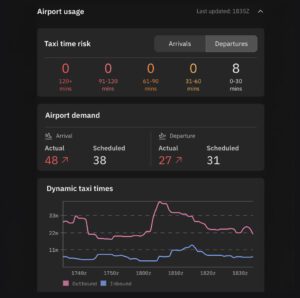
Predictive airport intelligence gives visibility into taxiway impacts
The role of aircraft weather forecasts in passenger safety
Beyond operational efficiency, aircraft weather forecasts play a crucial role in passenger safety and comfort. Unexpected turbulence, wind shear, and convective storms can pose risks to passengers and crew members, making accurate weather forecasting essential for smooth and safe flights. Our aviation solutions platform helps you maintain your commitment to safety through features such as:
- Total Turbulence Alerting: Provides real-time updates on turbulence intensity, allowing pilots to adjust altitude or flight paths before encountering rough air. This proactive approach enhances passenger comfort while significantly reducing the risk of in-flight injuries. Between 2009 and 2023, 79% of serious turbulence-related injuries involved crew members, highlighting the need for better turbulence-avoidance tools.4
- Global High-Resolution Atmospheric Forecasting (GRAF) system: Delivers hyper-localized forecasts with three times the resolution of conventional models. By providing detailed insights into convection, precipitation, and wind patterns, GRAF helps pilots make better-informed routing decisions. This reduces the likelihood of weather-related diversions and delays, contributing to a smoother travel experience for passengers.
- Runway Visual Range (RVR) forecast: Plays a vital role in flight safety by providing visibility data for takeoffs and landings. When combined with predictive analytics and real-time monitoring, these tools allow pilots and air traffic controllers to make informed decisions on instrument landing system minimums, minimizing disruptions and keeping flights operating safely.
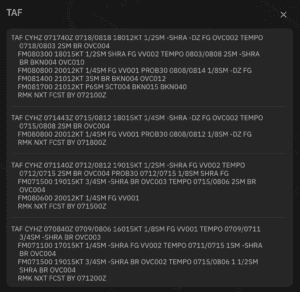
Easily access forecast conditions and quickly see how the forecast has been changing over time
A more efficient future for weather and airports
As the aviation industry continues to evolve, integrating advanced weather intelligence into airport operations will be key to improving efficiency and reducing delays. With the right airport operations technology, airports can anticipate and respond to aviation weather conditions more effectively, optimizing flight schedules, minimizing fuel waste, and enhancing passenger safety.
By leveraging predictive analytics, real-time weather monitoring, and high-resolution aircraft weather forecasts from the world’s most accurate forecaster,5 aviation leaders can transform how weather and airports interact. These innovations will not only lead to smoother operations but also create a more resilient and efficient air travel experience for airlines, crews, and passengers alike.
With the right tools, airports can turn weather challenges into opportunities for smarter, more sustainable aviation.
Let's talk
To learn more about our advanced aviation weather solutions, contact our aviation experts today.
Contact us1 Federal Aviation Administration, FAQ: Weather Delay, 2025
2 Upgraded Points, Upgraded Points Study Reveals Which Airports Waste the Most of Your Time While Traveling, 2024
4 Safety Compass, Flight Attendants Continue to Be Seriously Injured in Turbulence, 2023
5 ForecastWatch, Global and Regional Weather Forecast Accuracy Overview, 2021-2024, commissioned by The Weather Company
- Real-time weather data helps airlines reduce risks and improve safety during flights.
- Airlines deal with dangers like turbulence, storms, and volcanic ash, which can delay flights and affect safety.
- The Weather Company’s tools use data and real-time alerts to help pilots and dispatchers make better decisions.
- Advanced weather technology lowers costs, improves flight routes, and makes travel smoother for passengers.
- Using detailed weather data helps airlines stay prepared for disruptions and keep operations running smoothly.
The promise of on-time arrival hangs in the balance with every departure. Airlines follow tight schedules, so even small delays can cause bigger problems. A single disruption can push back flights, use up extra resources, and affect passengers. But the skies are full of changing weather that can turn an easy flight into a risky one. Turbulence, sudden wind changes, and surprise storms can make planning difficult and create serious safety concerns.
Airlines must manage these risks to keep passengers and crews safe while staying on schedule. That’s where real-time aviation weather risk management comes into play. By using advanced weather data from The Weather Company, airlines can better predict dangers, change flight paths when needed, and help make travel safer and smoother for everyone on board.
The importance of weather intelligence in aviation
Airlines deal with many weather challenges that can delay flights, affect safety, and increase costs. Risk management in aviation is crucial for addressing issues such as turbulence, icing, thunderstorms, and even volcanic ash clouds. Thunderstorms – especially those common in spring and summer – can rapidly intensify, bringing lightning, hail, and heavy rain that disrupt schedules and pose serious safety risks. Volcanic ash clouds are less frequent but far more dangerous; ash particles can damage aircraft engines and sensors in minutes, sometimes without any visual cues. Together, hazards like these highlight how weather plays a major role in flight safety – contributing to 39% of aviation accidents between 2008 and 2022, according to the National Transportation Safety Board (NTSB).¹
Turbulence is a leading cause of in-flight injuries. It accounts for the majority of injuries in commercial airline accidents, with cabin crew comprising nearly 80% of those injured, according to the NTSB.² Total Turbulence Alerting provides airlines with real-time aviation weather turbulence tracking, enabling them to monitor turbulence intensity along planned flight paths. For a flight from London to New York, pilots who get turbulence updates over the Atlantic can change altitude or reroute to smoother air.
Leveraging real-time data for enhanced safety
Severe weather events, particularly during hurricane season and training thunderstorms in the summer, pose significant threats to flight operations. According to the FAA, weather-related delays account for more than 74% of global flight delays, impacting both schedules and costs.³ The Weather Company’s Tropical Storm Tables with forecasted track, equip flight dispatchers with real-time updates on storm trajectories and intensities, allowing them to adjust flight paths proactively. This level of preparedness helps flights avoid hazardous areas, reducing the likelihood of cancellations, diversions, or, worse, accidents.

Similarly, aviation weather reports on icing conditions are vital for flights over colder regions. Icing can decrease an aircraft’s lift, increase drag, and ultimately compromise safety. Using predictive analytics – including Forecast Icing Potential and HIWC (high ice water content) Forecast – The Weather Company alerts airlines to potential icing zones. For instance, if a flight from Chicago to Denver is expected to encounter icing conditions over the Rockies, crews can be advised to activate de-icing measures or adjust cruising altitudes. This proactive approach helps maintain aerodynamics, improving flight safety and efficiency, even in challenging weather.
Managing volcanic ash and space weather
While less frequent, volcanic ash clouds pose severe risks to aviation safety. Ash particles can damage engines within minutes. Repair costs can reach significant amounts depending on the severity of the incident. Imagine a volcanic eruption near Southeast Asia, releasing ash into the atmosphere. The Weather Company’s volcanic ash tracking tools provide real-time alerts to reroute flights, avoiding volcanic ash flight disruption and protecting aircraft engines.
In addition to terrestrial weather, space weather events, such as solar flares, can disrupt communication systems and GPS signals and expose passengers and crew to solar radiation. While rare, these disruptions can be serious, especially for long-haul flights over remote regions. The Weather Company works with the Space Weather Prediction Center (SWPC), an entity of the National Oceanic and Atmospheric Administration located in Boulder, CO, to provide solar activity forecasts that inform operational planning and issue space weather advisories during impactful events.
Wind shear and sudden wind shifts
Wind shear and unexpected wind shifts, especially during critical phases like takeoffs and landings, can challenge even the most experienced pilots. Airports like Hong Kong International are known for their difficult wind conditions. Airlines receive real-time updates on wind patterns through METARs (current conditions) and TAFs (forecast conditions), which are accessible in MaverickTM Dispatch for streamlined access in dispatcher workflows. This helps pilots adjust their approaches and reduce the risk of hard landings or go-arounds. Not only does this enhance safety, but it also helps airlines avoid costly hard landing inspections that lead to aircraft downtime and reduce unnecessary fuel burn caused by go-arounds.
The strategic value of predictive analytics
Real-time weather data doesn’t only help with immediate dangers – it also makes flights more efficient. By leveraging tools like Pilotbrief® and Maverick Dispatch, airlines optimize flight routes by using accurate weather for flight path planning, take advantage of favorable wind conditions, and reduce fuel consumption. In fact, improving flight planning through advanced weather insights can significantly cut fuel burn and emissions.
Fuel efficiency
For a deeper look at how airlines can realize these savings, explore our guide on improving airline fuel efficiency with advanced weather insights. Weather-related operational disruptions are increasing, with Air Traffic Flow Management (ATFM) delays in Europe rising from an average of 0.13 minutes per flight in 2011 to 0.54 minutes in 2023, totaling 90,000 hours of delays.4
Maintenance planning
Predictive analytics also aids in maintenance planning. By minimizing exposure to turbulence and extreme weather, airlines can reduce unplanned maintenance costs. Weather delays as a proportion of total flight delays have increased from around 11% in 2012 to nearly 30% in 2023.5 In fact, the number of reports of large hail and heavy rain captured in the European Severe Weather Database rose by 18% in 2023 compared to 2022, highlighting the growing impact of extreme weather on aviation.6 These disruptions have significant cost implications for airlines, travelers, and the environment.
Predictive measures are a vital part of keeping operations efficient and protecting profits. In addition to weather analytics, The Weather Company also supports airlines through advanced airport arrival and departure capacity modeling and surface insights that accounts for weather-driven constraints. These models help predict how storms or wind shifts will impact runway configurations, arrival rates, and departure flows for better planning and fewer last-minute delays.
Improving passenger experience through weather intelligence

Beyond safety and efficiency, effective aviation weather risk management can significantly enhance the passenger experience. For instance, by using real-time weather insights to reroute flights away from areas of turbulence, airlines can offer smoother and more comfortable journeys.
Moreover, anticipating weather-related disruptions allows airlines to communicate proactively with passengers and enables them to adjust their plans – whether by leaving home later or spending more time enjoying their trip – instead of waiting at the gate in frustration. Whether adjusting schedules to avoid storms or managing delays due to low visibility at busy airports, leveraging weather data helps airlines build trust with their customers by demonstrating a commitment to safety and reliability.
Navigating the future of aviation with The Weather Company
Accurate, real-time weather data is essential in aviation, where even small disruptions can be costly. GRAF (Global High-Resolution Atmospheric Forecasting) delivers weather predictions six times faster and at three times the resolution of leading models. Within Maverick Dispatch, airlines gain access to advanced GRAF layers that offer deeper insights into rapidly evolving conditions, supporting faster and more informed operational decisions. Total Turbulence Alerting also provides expert insights to help pilots navigate rough conditions.
Predictive weather analytics from the world’s most accurate forecaster,7 can help airlines plan better routes, lower costs, and keep flights safe. Aviation solutions from The Weather Company help aviation leaders handle everyday challenges and rare extreme weather events to stay resilient in a competitive industry.
Let's talk
To learn more about our advanced aviation weather solutions, contact our aviation experts today.
Contact us¹National Transportation Safety Board (NTSB), NTSB Weather Related Accidents, 2024. Available at: NTSB
²National Transportation Safety Board (NTSB), Preventing Turbulence-Related Injuries in Air Carrier Operations Conducted Under Title 14 Code of Federal Regulations Part 121, 2021. Available at: NTSB
³Federal Aviation Administration (FAA), FAQ Weather Delay, 2024. Available at: FAA
4 5 6 International Air Transport Association (IATA), Weather-related operational disruptions are rising. Available at: IATA
7 ForecastWatch, Global and Regional Weather Forecast Accuracy Overview, 2021-2024, commissioned by The Weather Company







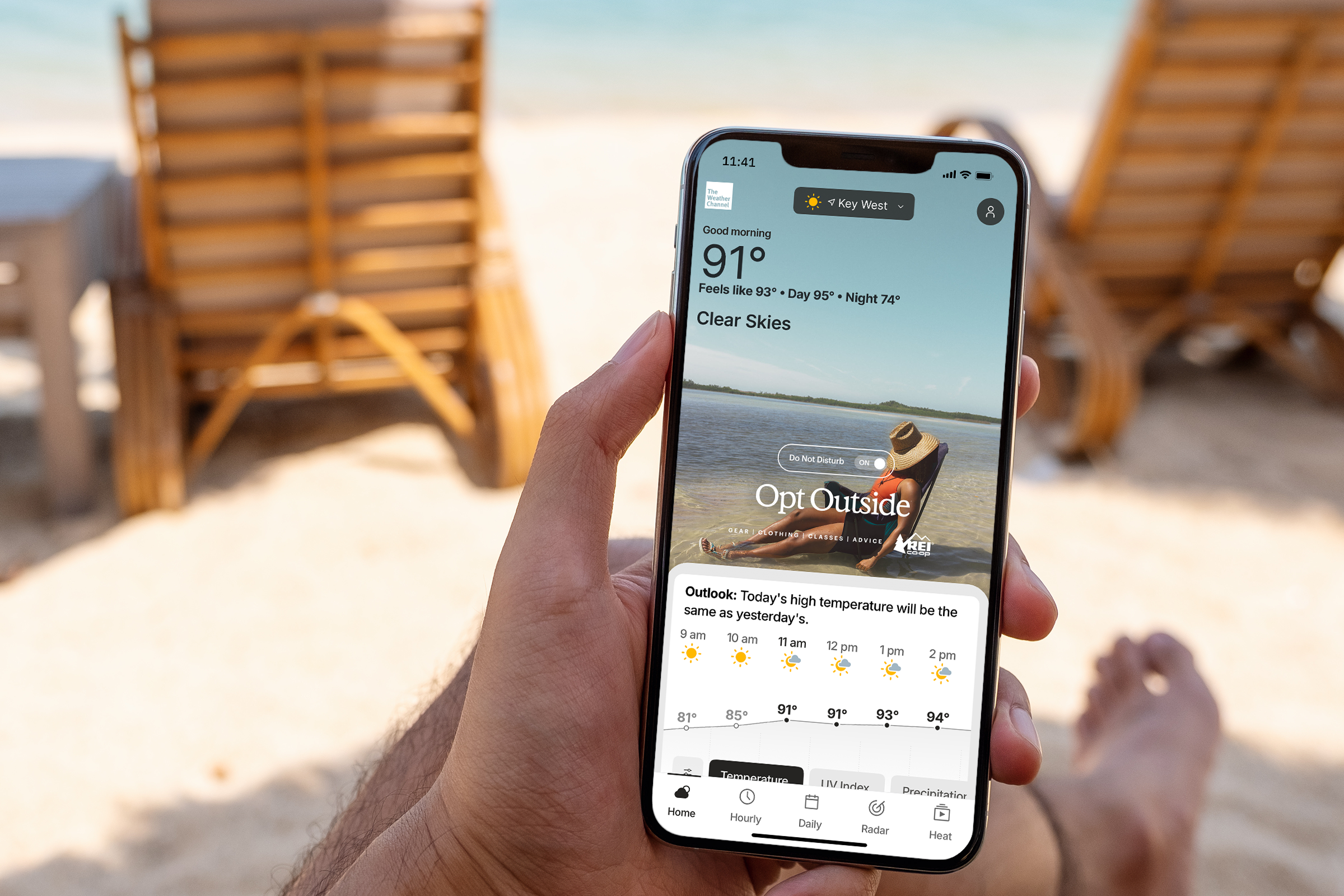
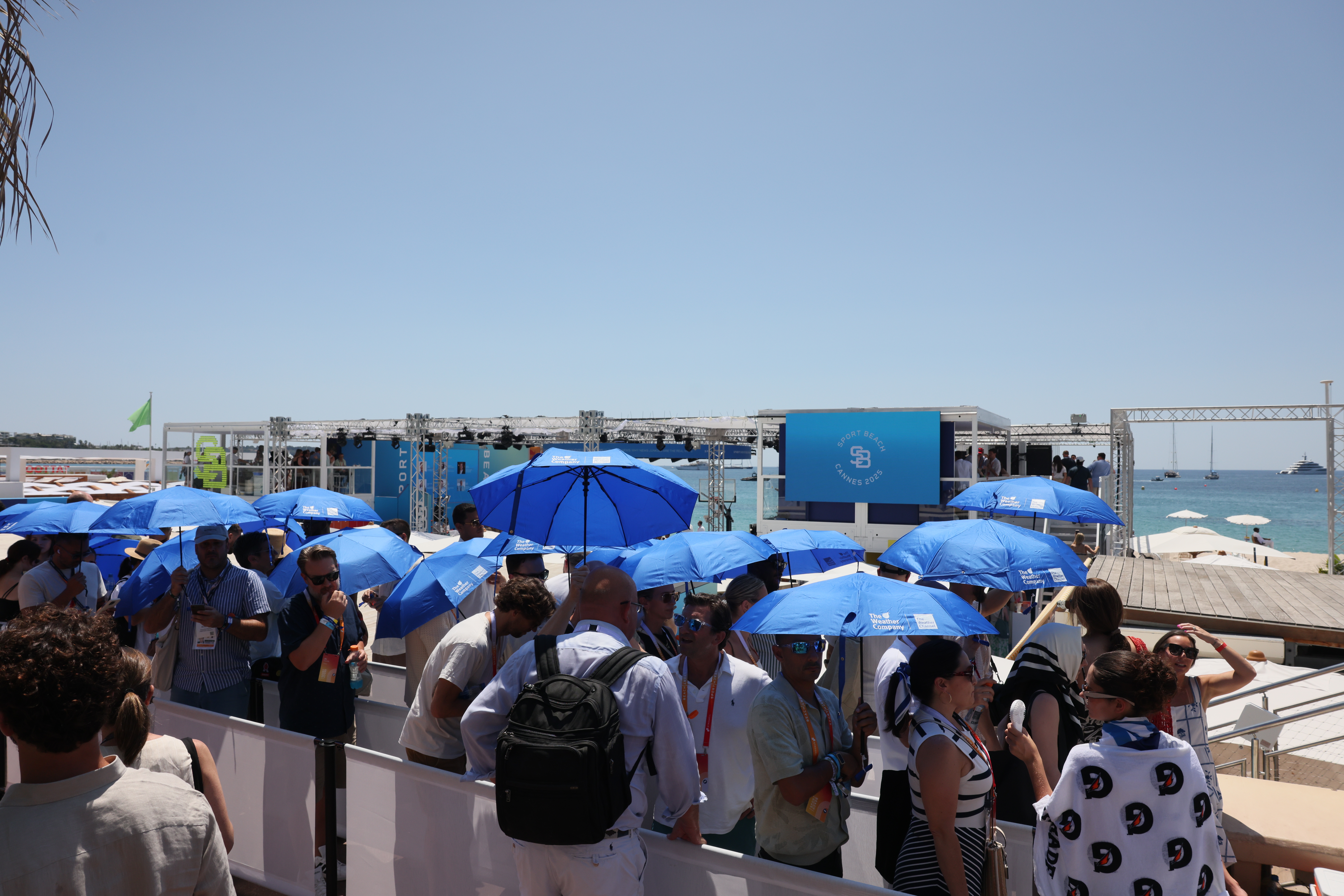





 Supply chain agility: Weather and supply chain factors can exacerbate disruptions, especially for temperature-sensitive goods. Granular weather forecasts can help anticipate potential delays and inform inventory management, ensuring you have the necessary ingredients on hand without overstocking (especially important when ingredient costs are fluctuating due to tariffs). For instance, knowing a major storm is approaching a key distribution hub allows for proactive adjustments to delivery schedules.
Supply chain agility: Weather and supply chain factors can exacerbate disruptions, especially for temperature-sensitive goods. Granular weather forecasts can help anticipate potential delays and inform inventory management, ensuring you have the necessary ingredients on hand without overstocking (especially important when ingredient costs are fluctuating due to tariffs). For instance, knowing a major storm is approaching a key distribution hub allows for proactive adjustments to delivery schedules.